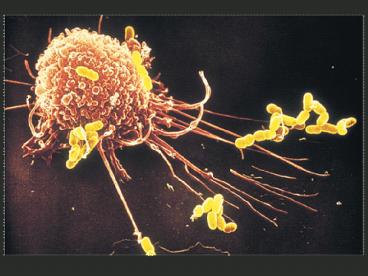Lecture 3 Outline (Ch. 7) - PowerPoint PPT Presentation
1 / 22
Title:
Lecture 3 Outline (Ch. 7)
Description:
Self-Check Self-Check Lecture 3 Outline (Ch. 7) ... proteins embedded in membrane Membrane structure freeze fracture proteins intact, ... – PowerPoint PPT presentation
Number of Views:231
Avg rating:3.0/5.0
Title: Lecture 3 Outline (Ch. 7)
1
(No Transcript)
2
Lecture 3 Outline (Ch. 7)
- I. Membrane Structure
- II. Membrane Proteins
- III. Permeability
- Transport Across Membranes
- A. Passive
- B. Facilitated
- C. Active
- D. Bulk
- V. Lecture Concepts
3
Membrane structure
1915, knew membrane made of lipids and proteins
Reasoned that membrane bilayer
Where to place proteins?
Lipid layer 1
Proteins
Lipid layer 2
4
Membrane structure
Experiment to determine membrane fluidity
marked membrane proteins mixed in hybrid cell
5
Membrane structure
Membrane fluidity
phospholipid f.a. tails saturation affects
fluidity
cholesterol buffers temperature changes
6
Membrane structure
fluid mosaic model 1970s
fluid phospholipids move around
mosaic proteins embedded in membrane
7
Membrane structure
freeze fracture
proteins intact, one layer or other
two layers look different
8
Membrane structure
cell membrane amphipathic
- hydrophilic hydrophobic
hydrophilic
hydrophobic
hydrophilic
membrane proteins inserted, also amphipathic
9
Membrane Proteins
Membrane proteins
Integral inserted in membrane
- transmembrane span mem.
Peripheral next to membrane
- inside or outside
10
Membrane Proteins
11
Selectively Permeable Membranes
Cell membranes only allow some molecules across
w/out help
Small, non-polar molecules OK ex. hydrocarbons,
O2, CO2
No charged, polar, or large molecules ex.
sugars, ions, water
12
Transport Across Membranes
- Types of transport
- Passive transport
- Facilitated diffusion
- Active transport
- Bulk transport
Energy Required? Directionality?
13
Passive Transport - Simple Diffusion
NO ENERGY required
- non-polar molecules (hydrocarbons, O2, CO2)
DOWN concentration gradient
molecules equally distribute across available
area
14
Passive Transport - Osmosis
osmosis movement of water across cell membrane
water moves via special channels
moves into/out of cell until solute
concentration is balanced
15
Passive Transport - Osmosis
tonicity solutes in solution in relation to
cell
- hypotonic fewer solutes in solution
- isotonic equal solutes in solution
- hypertonic more solutes in solution
16
Passive Transport - Osmosis
Paramecium example
regulate water balance
pond water hypotonic
water into contractile vacuole
water expelled
17
Facilitated Diffusion
NO ENERGY required
- Large, charged, polar (sugar, ions, water)
DOWN concentration gradient
Use transport proteins - channel or carrier
proteins
18
Active Transport
ENERGY IS required
- Usually ions or large molecules (Na, K,
glucose)
UP/AGAINST concentration gradient
transport carrier proteins
a. ion pumps
b. co-transporters
Ex. Na-K ion pump
- Na ions inside to out
- K ions outside to in
- net high Na outside, high K inside cell
19
Active Transport
ATP used pump H ions out
Ex. proton (H) pump
against concentration and charge gradients
gradients used by cell for energy potential
20
Bulk Transport
ENERGY IS required
Several or large molecules
Molecules moved IN - endocytosis
phagocytosis food in
pinocytosis water in
receptor-mediated endocytosis proteins bind
molecules, vesicles inside
Molecules moved OUT - exocytosis
21
Self-Check
Type of transport Energy required? Movement direction? Examples
Simple diffusion no Down conc. gradient O2, CO2, non-polar molecules
Osmosis
Facilitated diffusion
Active transport
Bulk transport
22
Lecture 3 concepts
- Describe the fluid mosaic model including
meaning and experimental evidence - List and describe types of membrane proteins
- Define amphipathic explain application to cell
membranes - Discuss what is meant by a selectively permeable
membrane and how this applies to cell membranes - Name types of transport across cell membranes and
describe each one - Given a tonicity of solution, determine direction
of water movement and hypothesize result on a
cell - Write out a list of new terminology and provide
descriptions































